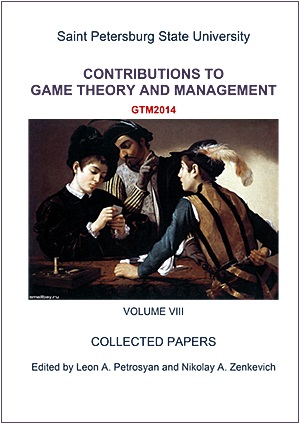Strategic Stability of Coalitions Technological Alliance Parameters: a Two-Level Cooperation
Abstract
The paper is devoted to two-level cooperation in differential games. Cooperative differential games are one of the fastest growing parts of the game theory. They are widely used for modeling the conflict-controlled processes in various fields, especially in management and economics. The solution of differential game is a cooperative agreement, and the selected principle of optimality, according to which the received payoff is distributed. The main problem of many cooperative solutions is the instability over time. Studies showed that initially selected cooperative solution often loses its optimality over time. Therefore, the question arose about the stability of the co-operative solutions. The stability can be understood as dynamic stability (time consistency), strategic stability or protection from irrational behavior. The concept of dynamic stability was formalized by L.A. Petrosyan. Cooperative solution is dynamically stable, if the principle of optimality, selected early in the game keeps its consistency throughout the gameplay. For dynamic stability is necessary at each moment of time to carry out the regularization of the chosen principle of optimality. For this regularization L.A. Petrosyan proposed to use the redistribution of received payoff in accordance with the "imputation distribution procedure". Petrosjan (1993) and Petrosjan and Zenkevich (1996) presented a detailed analysis of dynamic stability in cooperative differential games, in which the method of regularization was introduced to construct time-consistent solutions. Yeung and Petrosjan (2001) designed time-consistent solutions in differential games and characterized the conditions that the allocation-distribution procedure must satisfy. Petrosjan (2003) employed the regularization method to construct time-consistent bargaining procedures.
The strategic stability of cooperative solution means, that no individual deviation from the cooperation of each member brings benefits the decline member. This means that the outcome of this cooperative agreement is reached at some Nash equilibrium, which will guarantee the strategic support for such cooperation.
Recently in differential games are studied coalitional solutions in which the coalitions act as individual players. Coalitions can play with each other in a non-cooperative game, then payoff of each coalition is distributed among its members in accordance with some principle of optimality. But coalitions-players can cooperate to increase the joint payoff. In this case the joint payoff is distributed between coalitions according to some principle of optimality then coalition's share of joint payoff is distributed between its participants according to maybe other principle of optimality. This cooperation is called two-level cooperation. Optimality principles of payoff distribution between coalitions and within coalition may be different.
To solve such cooperative models which requires at both levels of the cooperation it is necessary to build the characteristic function and imputation distribution procedure. This paper describes a model of a two-level cooperation in the technological alliance differential game. Participants of the game are the firms with the some technology that brings profit. On the first (lower) level firms form coalitions to increase joint profit. On the second (upper) level coalitions act as individual players and also form the one grand coalition to maximize the joint payoff. The top-level payoff is distributed between coalitions-participants according to some principle of optimality. Thus, each coalition-participants may get more than would receive by playing individually. Then each coalition distributes the its share of joint payoff among its firms-members. This article also presented a stable cooperative solution in this model. For its implementation at every level of cooperation we build the characteristic function and prove its superadditivity. As a principle of optimality the dynamic Shapley value is selected. Proved the dynamic stability and the strategic stability of cooperative soluton. The results are illustrated by a quantitative example.
Keywords:
differential game, cooperation, imputation distribution procedure, dynamic stability, strategic stability
Downloads
References
Downloads
Published
How to Cite
Issue
Section
License
Articles of "Contributions to Game Theory and Management" are open access distributed under the terms of the License Agreement with Saint Petersburg State University, which permits to the authors unrestricted distribution and self-archiving free of charge.




